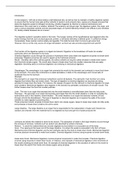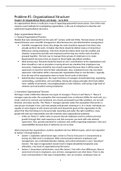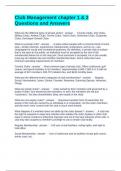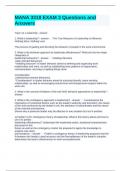Week 5: Transdiagnostic approach
Sauer-Zavala et al. (2017) – Current definitions of ‘’transdiagnostic’’ in treatment development: a
search for consensus
Aim of the study
Outline 3 principal ways in which the term transdiagnostic is currently used, to delineate treatment
approaches that fall into these three categories, and to consider potential advantages and
disadvantages of each approach.
Criteria by Mansell et al. (2009)
Transdiagnostic processes require to be assessed in both clinical and non-clinical samples and be
present in a minimum of four disorders.
Descriptively transdiagnostic: Processes that are present in a range of disorders.
Mechanistically transdiagnostic: Processes that reflect a causal, functional mechanism for co-
occurrence. Mechanistically transdiagnostic constructs provide information regarding the development
and maintenance of a class of disorders; in other words, they represent common or core vulnerabilities
that put an individual at risk for more than one mental health diagnosis as similar underlying processes
are driving symptoms across conditions.
Whereas the designation “mechanistically transdiagnostic” implies that the construct in question is
causally related to a range of psychopathology, the term “descriptively transdiagnostic” suggests only
that a construct is present in multiple disorders, without regard to how or why.
Example descriptively transdiagnostic construct
Low self-esteem Although low self-esteem may be descriptively transdiagnostic, there is no
unifying theory to account for how low self-esteem contributes to the development and
maintenance of these disorders. As such, it does not appear to be mechanistically
transdiagnostic; therefore, specifically targeting low self-esteem in treatment may not lead
directly to alleviation of specific psychopathological processes maintaining symptoms.
Example mechanistically transdiagnostic construct
Overvaluation of shape and weight Has been implicated as a core functional mechanism in
the development and maintenance of symptoms across anorexia, bulimia, and eating disorders
not otherwise specified.
Rumination Contributes to the development and maintenance of a range of emotional
disorders (e.g., depression, anxiety, borderline personality disorder.
The emotional cascade model
Model in which rumination is used as a strategy for coping with negative emotions, leading to increased
levels of negative affect, followed by more rumination, and so on, until a physically potent behavior (e.g.,
non-suicidal self-injury, substance use) occurs and serves to distract from negative thoughts and
emotions.
, Advantages to exploring mechanistically transdiagnostic processes over descriptively
transdiagnostic processes
Reserving the term transdiagnostic to refer to underlying mechanisms that are relevant across a
class of disorders may function to better inform treatment development, as strategies can be
included that focus on these core deficits rather than targeting what may be more trivial disorder
correlates.
Continued identification of mechanistically transdiagnostic processes may lead to more efficient
treatments because targeting underlying mechanisms has been shown to lead to clinical
improvement across comorbid conditions that are maintained by the same core vulnerabilities.
Transdiagnostic treatment
Advantages of transdiagnostic approach over single-diagnosis protocols:
There is a high degree of diagnostic comorbidity among DSM disorder and single-diagnosis
protocols do not provide guidelines on how to address co-occurring diagnoses.
They may substantially reduce therapist training burden. Therapists only need to receive
training in one protocol in order to provide evidence-based treatment for a range of disorders,
rather than completing costly and time-intensive training for multiple interventions.
Three categories into which transdiagnostic treatments can be placed:
1. Universally applied therapeutic principles: interventions in which a guiding therapeutic
strategy is universally applied across the range of presenting conditions. This category
includes traditional psychotherapy emanating from a variety of theoretical perspectives (e.g.,
psychodynamic, cognitive-behavioral) that has only recently been described as transdiagnostic,
despite a history of being universally applied to most, if not all, psychopathology.
2. Modular approach: Approach wherein a clinician chooses from an assembled bank of discrete
strategies to create a treatment that maps onto any patient’s presenting problems, regardless of
the diagnosis.
3. Shared mechanisms approach: interventions that explicitly target shared mechanisms
implicated in the development and maintenance of certain classes of psychopathology.
Universally applied therapeutic principles (top-down approach)
Theory is used to guide accounts of how therapy should be conducted (e.g., by targeting transference)
and interventions within this category represent “top-down” efforts to apply an existing therapeutic
technique to multiple disorders without explicit consideration for whether all disorders treated with that
technique are maintained by similar processes.
This approach is in contrast to “bottom-up” efforts, in which theoretical models of psychopathology are
identified and then intervention strategies are crafted to target them, as is the case for shared
mechanisms treatment.
Examples of universally applied treatment:
Humanistic psychotherapy Humanistic psychology (Maslow): based on the notion that
humans are inherently good, capable of exercising free will, and motivated to self-actualize, and
that psychopathology develops from obstacles to the pursuit of self-actualization. The emphasis
is not on alleviating symptoms, but rather providing a healing context regardless of presenting
problem.
o Client-centered therapy (Rogers)
Sauer-Zavala et al. (2017) – Current definitions of ‘’transdiagnostic’’ in treatment development: a
search for consensus
Aim of the study
Outline 3 principal ways in which the term transdiagnostic is currently used, to delineate treatment
approaches that fall into these three categories, and to consider potential advantages and
disadvantages of each approach.
Criteria by Mansell et al. (2009)
Transdiagnostic processes require to be assessed in both clinical and non-clinical samples and be
present in a minimum of four disorders.
Descriptively transdiagnostic: Processes that are present in a range of disorders.
Mechanistically transdiagnostic: Processes that reflect a causal, functional mechanism for co-
occurrence. Mechanistically transdiagnostic constructs provide information regarding the development
and maintenance of a class of disorders; in other words, they represent common or core vulnerabilities
that put an individual at risk for more than one mental health diagnosis as similar underlying processes
are driving symptoms across conditions.
Whereas the designation “mechanistically transdiagnostic” implies that the construct in question is
causally related to a range of psychopathology, the term “descriptively transdiagnostic” suggests only
that a construct is present in multiple disorders, without regard to how or why.
Example descriptively transdiagnostic construct
Low self-esteem Although low self-esteem may be descriptively transdiagnostic, there is no
unifying theory to account for how low self-esteem contributes to the development and
maintenance of these disorders. As such, it does not appear to be mechanistically
transdiagnostic; therefore, specifically targeting low self-esteem in treatment may not lead
directly to alleviation of specific psychopathological processes maintaining symptoms.
Example mechanistically transdiagnostic construct
Overvaluation of shape and weight Has been implicated as a core functional mechanism in
the development and maintenance of symptoms across anorexia, bulimia, and eating disorders
not otherwise specified.
Rumination Contributes to the development and maintenance of a range of emotional
disorders (e.g., depression, anxiety, borderline personality disorder.
The emotional cascade model
Model in which rumination is used as a strategy for coping with negative emotions, leading to increased
levels of negative affect, followed by more rumination, and so on, until a physically potent behavior (e.g.,
non-suicidal self-injury, substance use) occurs and serves to distract from negative thoughts and
emotions.
, Advantages to exploring mechanistically transdiagnostic processes over descriptively
transdiagnostic processes
Reserving the term transdiagnostic to refer to underlying mechanisms that are relevant across a
class of disorders may function to better inform treatment development, as strategies can be
included that focus on these core deficits rather than targeting what may be more trivial disorder
correlates.
Continued identification of mechanistically transdiagnostic processes may lead to more efficient
treatments because targeting underlying mechanisms has been shown to lead to clinical
improvement across comorbid conditions that are maintained by the same core vulnerabilities.
Transdiagnostic treatment
Advantages of transdiagnostic approach over single-diagnosis protocols:
There is a high degree of diagnostic comorbidity among DSM disorder and single-diagnosis
protocols do not provide guidelines on how to address co-occurring diagnoses.
They may substantially reduce therapist training burden. Therapists only need to receive
training in one protocol in order to provide evidence-based treatment for a range of disorders,
rather than completing costly and time-intensive training for multiple interventions.
Three categories into which transdiagnostic treatments can be placed:
1. Universally applied therapeutic principles: interventions in which a guiding therapeutic
strategy is universally applied across the range of presenting conditions. This category
includes traditional psychotherapy emanating from a variety of theoretical perspectives (e.g.,
psychodynamic, cognitive-behavioral) that has only recently been described as transdiagnostic,
despite a history of being universally applied to most, if not all, psychopathology.
2. Modular approach: Approach wherein a clinician chooses from an assembled bank of discrete
strategies to create a treatment that maps onto any patient’s presenting problems, regardless of
the diagnosis.
3. Shared mechanisms approach: interventions that explicitly target shared mechanisms
implicated in the development and maintenance of certain classes of psychopathology.
Universally applied therapeutic principles (top-down approach)
Theory is used to guide accounts of how therapy should be conducted (e.g., by targeting transference)
and interventions within this category represent “top-down” efforts to apply an existing therapeutic
technique to multiple disorders without explicit consideration for whether all disorders treated with that
technique are maintained by similar processes.
This approach is in contrast to “bottom-up” efforts, in which theoretical models of psychopathology are
identified and then intervention strategies are crafted to target them, as is the case for shared
mechanisms treatment.
Examples of universally applied treatment:
Humanistic psychotherapy Humanistic psychology (Maslow): based on the notion that
humans are inherently good, capable of exercising free will, and motivated to self-actualize, and
that psychopathology develops from obstacles to the pursuit of self-actualization. The emphasis
is not on alleviating symptoms, but rather providing a healing context regardless of presenting
problem.
o Client-centered therapy (Rogers)







